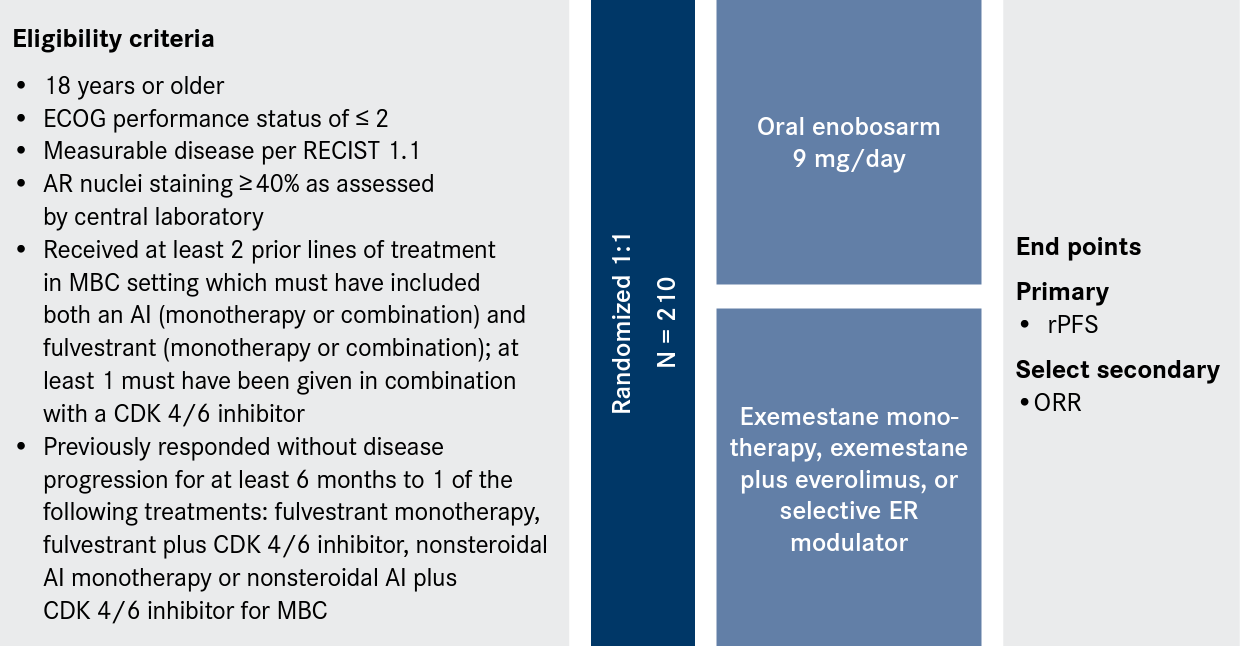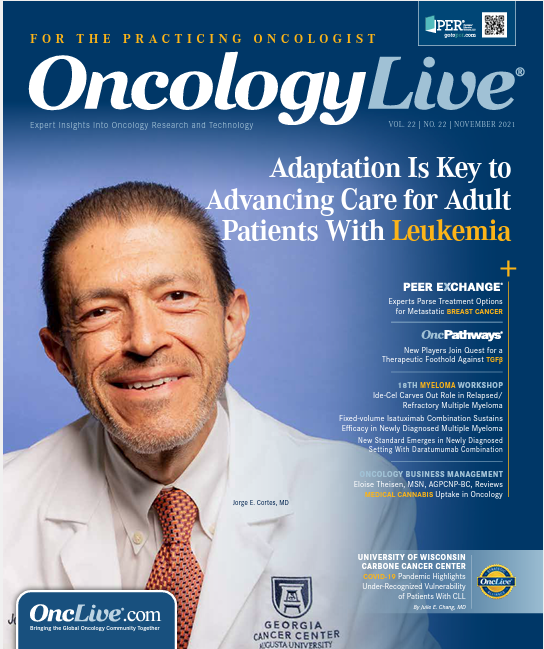Publication
Article
Enobosarm Study Aims to Establish New Class of Endocrine Treatment in Metastatic Breast Cancer
Author(s):
Investigators hope to improve upon the efficacy and tolerability of androgens in the treatment of breast cancer with the October 13, 2021, initiation of the phase 3 ARTEST trial.
Erica L. Mayer, MD

The viralizing effects of androgen agents previously limited their use in the treatment of breast cancer. Investigators hope to improve upon the efficacy and tolerability of androgens with the October 13, 2021, initiation of the phase 3 ARTEST trial (NCT04869943).1,2
Investigators will examine the efficacy of enobosarm in patients with androgen receptor (AR)–positive, estrogen receptor (ER)–positive, HER2-negative metastatic breast cancer (MBC) who have experienced tumor progression after treatment with estrogen-blocking agents and CDK 4/6 inhibitors.
In normal breast tissue, androgens inhibit cellular proliferation. AR is the most abundantly expressed sex hormone receptor in breast cancers; 70% to 95% of breast cancers are AR-positive and AR is recognized as a prognostic marker for outcomes to breast cancer treatment. In ER-positive breast cancer, AR agonists previously have been shown to inhibit tumor growth, and an unmet need exists for those patients who have exhausted ER-targeting agents.2
“Enobosarm is a nonsteroidal selective AR agonist,” said Erica L. Mayer, MD, MPH, a senior physician and breast cancer medical oncologist at Dana-Farber Cancer Institute in Boston, Massachusetts. “It binds to the AR and helps to suppress the growth of hormone receptor–positive breast cancer cells in vitro. This [process] works particularly well in models where the disease is resistant to prior endocrine therapies.” Mayer added that this observation led to the interest in studying the mechanism in patients who have undergone prior endocrine therapy.
Initial Efficacy and Safety Data of Enobosarm
ARTEST investigators will build on previously reported efficacy and safety data from a phase 2 trial (NCT02463032) of enobosarm. In the phase 2 trial, participants had AR-positive, ER-positive, HER2-negative MBC; were heavily pretreated; and had progressed after treatment with multiple lines of endocrine therapy. The open-label, multinational trial enrolled 136 postmenopausal women to be treated with either enobosarm 9 mg (n = 72) or enobosarm 18 mg (n = 64). The study’s primary efficacy end point was to determine clinical benefit rate (CBR) by RECIST 1.1 in patients with AR-positive disease treated at 6 months.2,3
AR status was centrally assessed, centrally and patients with 10% or greater AR-positivity were included in the study. Patients with AR-negative, not determined, or uninformative status were not evaluable. Patients needed to have responded to adjuvant endocrine therapy for at least 3 years or to their most recent endocrine therapy for metastatic disease for at least 6 months to be included in the trial.
The median age in the 9-mg cohort was 60.5 years (range, 35-83) and 62.5 years (range, 42-81) in the 18-mg cohort. Prior chemotherapy was administered in 90% and 92.3% of patients in the 9-mg group and the 18-mg group, respectively. The median number of prior lines of endocrine therapy was 3 for both dose levels.
Among the 50 efficacy-evaluable patients in the 9-mg cohort, the CBR at 24 weeks was 32% (95% CI, 19.5%-46.7%). The 24-week CBR in the 18-mg group (n = 52) was 29% (95% CI, 17.1%-43.1%).3
Investigators noted a correlation between radiographic progression-free survival (rPFS) and the degree of AR nuclei staining. In an exploratory analysis, investigators determined that 40% AR staining was the optimal cutoff point for differentiating the benefit of treatment with enobosarm. The median rPFS for patients with greater than 40% AR staining (n = 24) was 5.5 months compared with 2.75 months for patients with less than 40% AR staining (n = 22). The objective response rate (ORR) was 50% vs 0%, respectively, and the CBR was 79% vs 18%, respectively (P < .0001).3
In terms of safety, most adverse effects (AEs) reported in the study were grade 1/2. Serious AEs occurred at a rate of 10.7% vs 16.4% in the 9-mg group and 18-mg group, respectively. No treatment-emergent AEs that led to death were observed.
Investigators concluded that AR could potentially be utilized as a biomarker to identify a subset of patients with ER-positive and HER2-negative advanced breast cancer who are most likely to respond to enobosarm. They also noted that enobosarm appeared to be safe and well tolerated with no virilizing AEs. The phase 3 dose for the ARTEST trial was deter-mined to be 9 mg, and the threshold for AR-positivity was set at a minimum of 40% AR nuclei staining.
“The 9-mg dose had much less toxicity and performed equally well,” Mayer noted. “This agent has some favorable effects. We always talk about AEs being bad, but this drug actually has some favorable effects, including building muscle mass and treat-ing osteoporosis.”
Enobosarm for the Treatment of Metastatic AR-positive, ER-positive, HER2-negative MBC4

Details of the ARTEST Trial
The ARTEST trial is an open-label random-ized, active control pivotal study that will enroll approximately 210 adult patients across 49 sites in the United States and Europe (Figure4).
Patients will be randomized 1:1 to either the enobosarm treatment group or the control treatment group. Patients in the enobosarm group will be treated with 9 mg of oral enobosarm daily until disease progression or unacceptable AEs are observed. The control group will receive an ER-targeted therapy of the investigator’s choice, limited to exemestane monotherapy, exemestane plus everolimus (Afinitor), or a selective ER modulator.
To be included in the trial, patients must have measurable disease by RECIST 1.1 and an ECOG performance status of 2 or less. Patients must have previously responded to fulvestrant monotherapy, fulvestrant plus CDK 4/6 inhibitor, nonsteroidal aromatase inhibitor monotherapy, or nonsteroi-dal aromatase inhibitor plus CDK 4/6 inhibitor for MBC.
Patients who have undergone more than 1 course of systemic chemotherapy for the treatment of MBC will be excluded from the study. Patients with a biliary catheter, creatinine clearance less than 30 mL/min as measured by the Cockcroft-Gault formula, or a known hypersensitivity or allergy to enobosarm also will not be eligible.
The primary end point of the trial is efficacy, measured by median rPFS. The secondary end point is ORR. Safety follow-up visits will take place approxi-mately 30 days after the last dose of study drug. After the safety follow-up visit, survival follow-up visits will be done monthly for 1 year and every 90 days after 1 year. The study is expected to be completed by April 30, 2023.
“We try to keep our patients with meta-static hormone receptor–positive breast cancer on endocrine therapies as long as possible, as long as they are effective and controlling the cancer,” Mayer said. “Eventually, these cancers become resistant to endocrine therapies, and we have to make a jump into the chemotherapy category. That’s a moment we try to put off as long as possi-ble [because] endocrine therapies can be so effective and well tolerated, particularly vs chemotherapy. The hope is that this trial will help to develop a new novel endocrine therapy for our patients that will help effectively treat their cancers and delay the time to transition to chemotherapy.”
References
- Veru enrolls first patient in international phase 3 ARTEST clinical trial of enobosarm in metastatic breast cancer. News release. Veru Inc. October 13, 2021. Accessed November 4, 2021. bit.ly/3bCHWqW
- Palmieri C, Linden HM, Birrell, et al. Phase 2 clinical study: efficacy of enobosarm, a selective androgen receptor (AR) targeting agent, in patients with metastatic AR+/ER+ advanced breast cancer resistant to estrogen receptor targeted agents and CDK 4/6 inhibitor in a phase 2 clinical study. Ann Oncol. 2021;32(suppl 2):S66. doi:10.1016/j.annonc.2021.03.114
- Palmieri C, Linden HM, Birrell, et al. Efficacy of enobosarm, a selective androgen receptor (AR) targeting agent, correlates with the degree of AR positivity in advanced AR+/estrogen receptor (ER)+ breast cancer in an international phase 2 clinical study. J Clin Oncol. 2021;39(suppl 15):1020. doi:10.1200/JCO.2021.39.15_suppl.1020
- Efficacy evaluation of enobosarm monotherapy in treatment of AR+/ER+/HER2- metastatic breast cancer (ARTEST). Updated November 1, 2021. Accessed November 4, 2021. https://clini-caltrials.gov/ct2/show/NCT04869943










